The Garmin Fenix 8 AMOLED is the latest generation of what's widely regarded as one of the most premium GPS outdoor watches on the market. It's an impressive beast.
A major change is that you've now got two options in terms of screen technology. There's either a pixel-based display with solar charging for enhanced battery life, or a super-crisp AMOLED display, effectively replacing the older Epix line of watches. Both models come in various case sizes to suit different wrists: 43mm (AMOLED only), 47mm or 51mm.
The headline improvements over the Fenix 7 are significant. You now get a microphone and speaker for calls and voice commands, diving-related functions including a depth gauge, and increased display dimensions for the smaller-sized watches. There's also a surprisingly useful LED flashlight at the top.
Although the battery life is inferior to the solar model, the AMOLED version still has competitive specs, with the 43mm version on test here providing up to 10 days in smartwatch mode and 28 hours in standard GPS mode (more on battery life later).
Depending on which model you choose, you get a durable stainless steel or titanium bezel in a range of finishes, plus a highly scratch-resistant sapphire crystal and 100m water resistance.
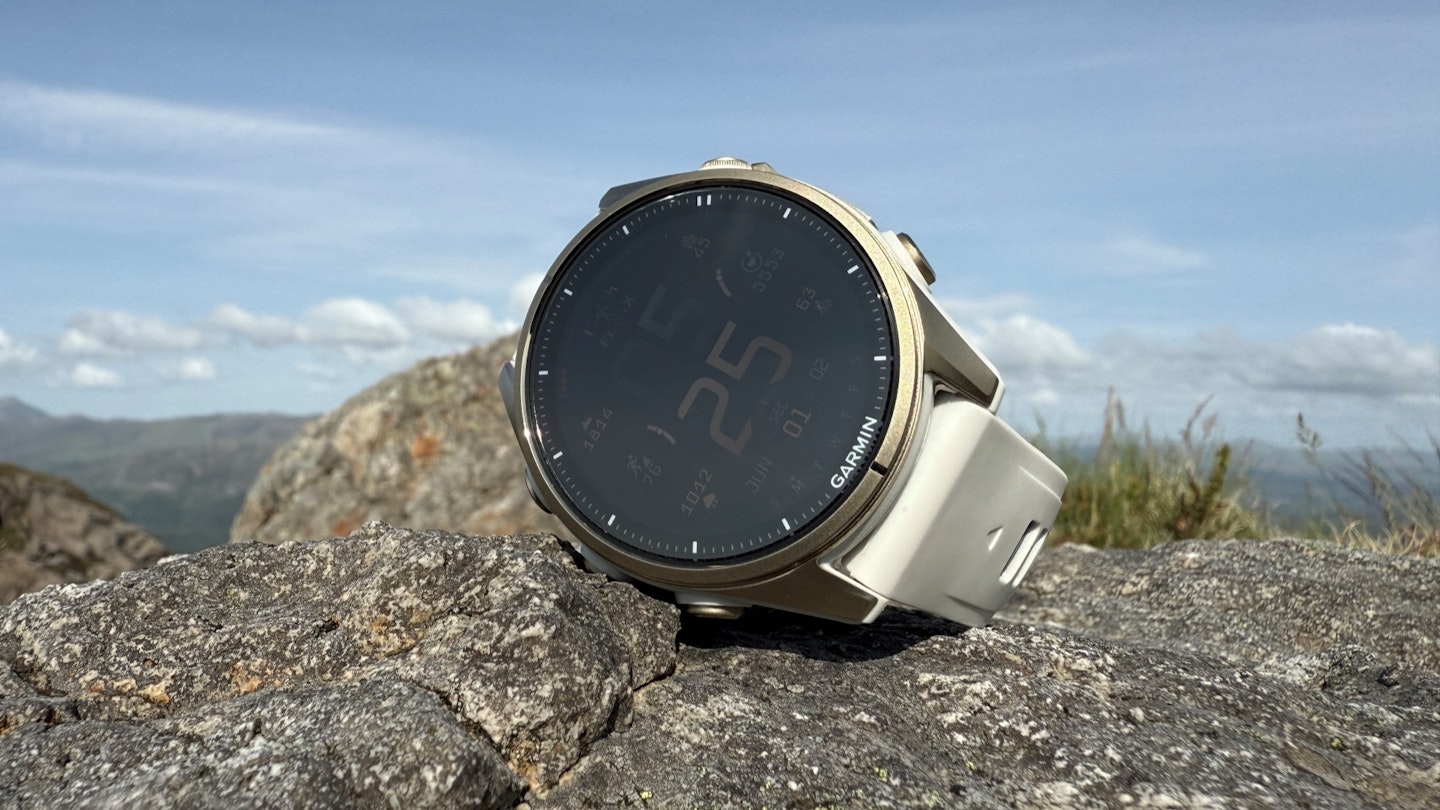 LFTO/Matt Jones
LFTO/Matt JonesPros
- Crisp, clear and bright AMOLED screen readable in all light conditions
- Built-in microphone and speaker for calls and voice commands
- Dedicated LED flashlight that's surprisingly useful
- Excellent full-colour mapping with detailed topographical data
- Comprehensive feature set with over 100 activity profiles
- Premium build quality with titanium options
Cons
- Extremely expensive starting at £880
- Complex interface overwhelming for newcomers
- Shorter battery life than solar alternatives
- Feature overkill for casual users
- Risk of damage anxiety given the investment
| RRP: | £879.99/$1,099.99 |
| Variants: | 43mm, 47mm, 51mm (plus solar options for two larger sizes) |
| Battery life (smartwatch mode): | Up to 10 days (43mm), 16 days (47mm), 29 days (51mm) |
| Battery life (All Systems GPS): | Up to 23 hours (43mm), 38 hours (47mm), 68 hours (51mm) |
| Display type and size: | AMOLED, 416 x 416px resolution, 35.3mm (43mm case) |
| Weight: | 60g/2.1oz - 43mm version |
| Waterproof rating: | 10 ATM / 100m |
Equipped with advanced health and fitness tracking capabilities, the Fenix 8 AMOLED supports over 100 activity profiles. It also offers comprehensive navigation features, such as multi-band GNSS support and preloaded topographical maps, facilitating fast and accurate tracking. The watch includes smart features like music storage, plus contactless payments via Garmin Pay.
The main drawback is its eye-watering price point. Starting at £880 ($1,100) for the 43mm version and climbing towards £1,000 ($1,200) for the premium variants, it's much more expensive than alternatives in our outdoor watch group test. Even if you can afford it, you might find yourself so worried about damaging such an expensive piece of kit that it puts you off wearing it for all your outdoor adventures.
Design and display
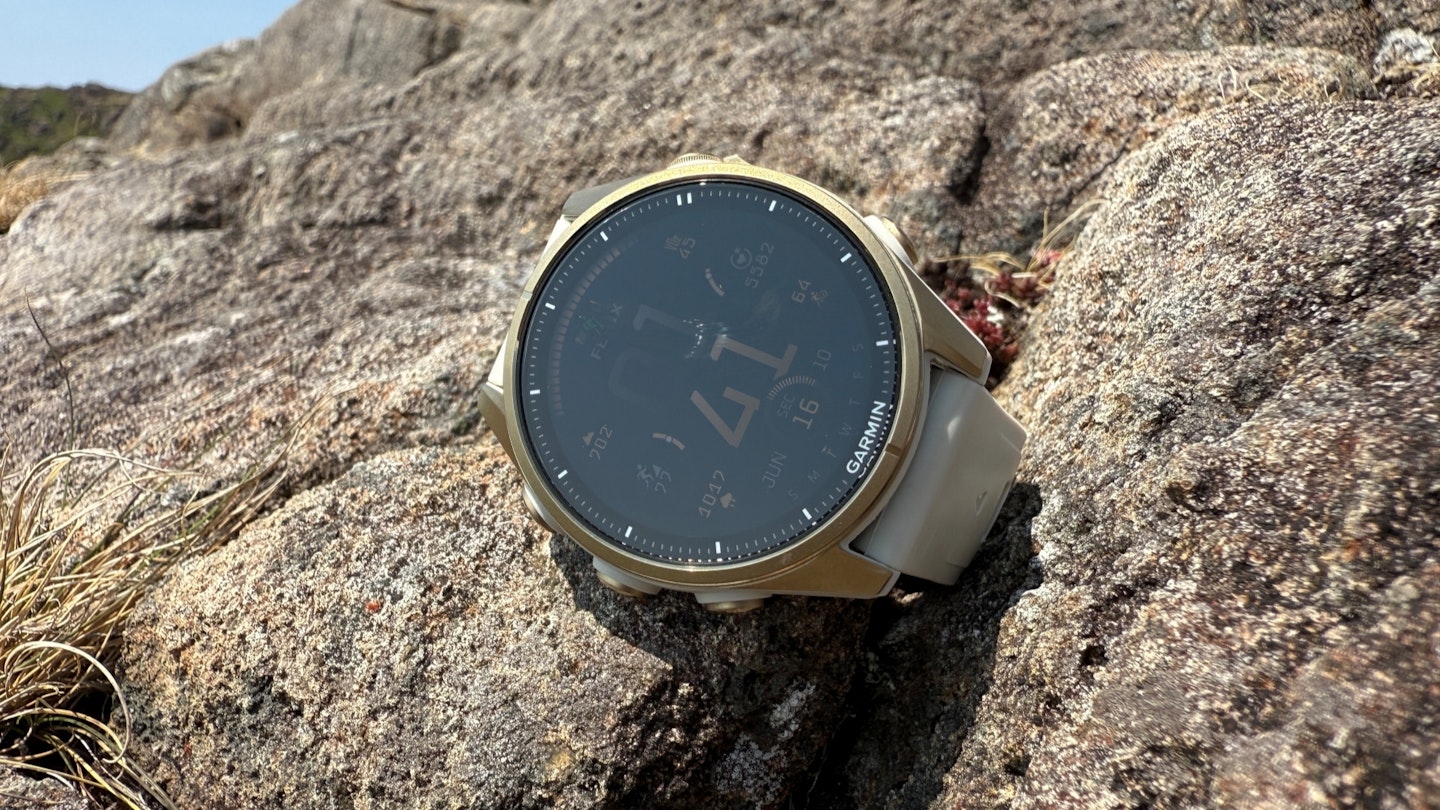
The Garmin Fenix 8 looks very similar in design to its predecessors in the Fenix range, but the AMOLED screen elevates the entire experience the moment you boot it up. The crisp, bright, responsive display means you can quickly glance at the watch even in challenging light conditions and immediately see what you need, whether you're checking stats mid-activity or using the impressive mapping functionality.
Coming from the memory-in-pixel (MiP) screen technology of previous generations, which often involved a fair amount of squinting and angle adjustment, the AMOLED display is a genuine game-changer.
The colours pop, text is razor-sharp, and map details that were difficult to discern on older screens now leap out with clarity. That said, the Fenix 8 is still available with the duller MiP screen, which is more battery-efficient – so if extended battery life is your priority, that remains the better option.
The sapphire crystal glass provides excellent scratch resistance, meaning you can use and abuse the Fenix without constantly worrying about damage. This is a significant upgrade over all mineral glass alternatives, even Gorilla Glass.
Meanwhile, the case construction uses Garmin's fibre-reinforced polymer with a metal caseback, while the standard silicone strap is comfortable and easy to clean, though readily swappable if you prefer different materials.
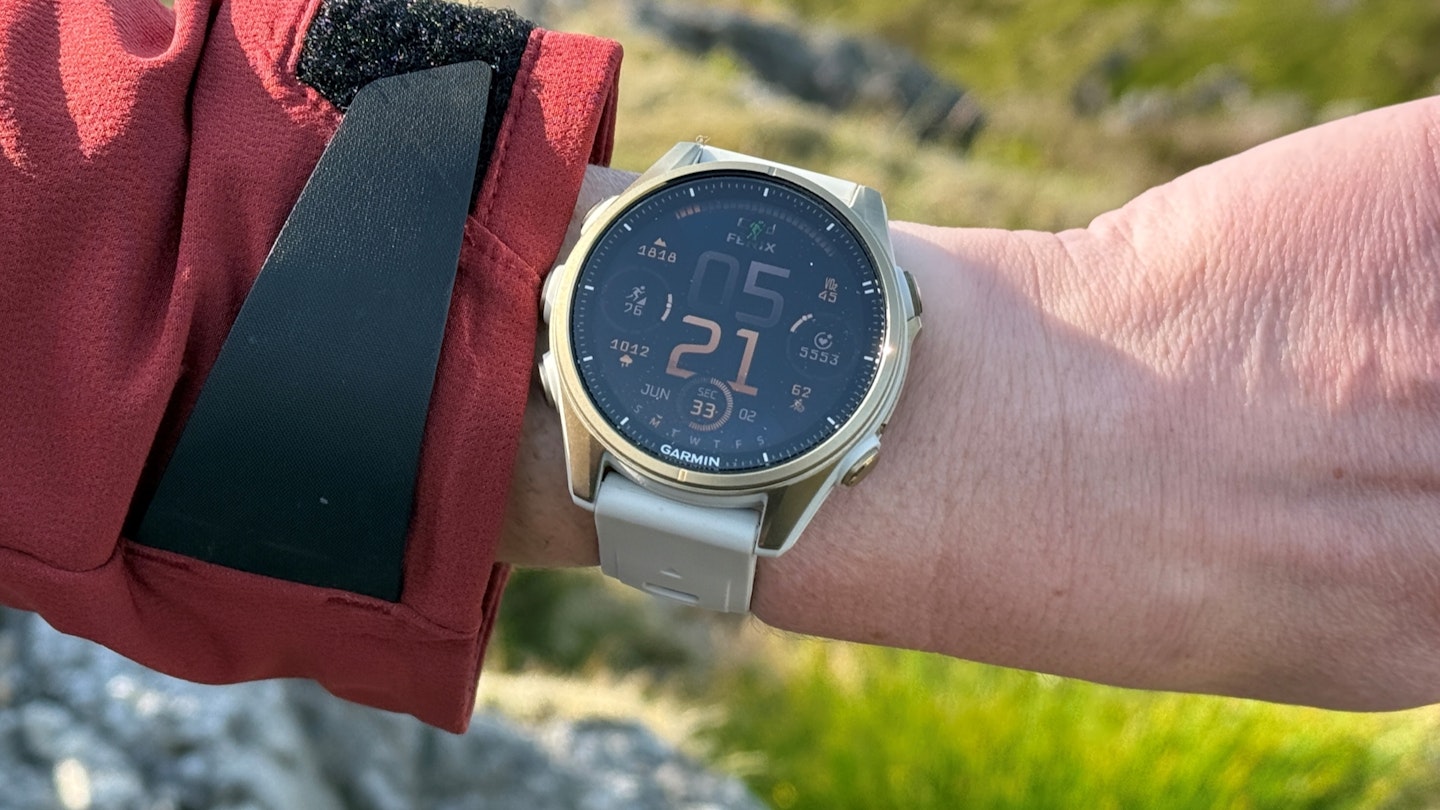
Although the Fenix 8 has a super-responsive touchscreen, Garmin has wisely retained the standard five-button layout, giving you the choice in how to navigate the watch's extensive features. This should suit different user preferences and conditions.
The 43mm version's 33mm diameter display is the smallest in the Fenix 8 range, but it's still plenty large enough to display all necessary information clearly. The compact size sits comfortably on most wrists without feeling bulky or heavy, making it suitable for extended wear.
The external LED flashlight at 12 o'clock initially seems gimmicky, but proves surprisingly useful in practice. When wild camping or navigating in darkness, having a torch literally at your wrist eliminates the need to fumble for a headtorch, making those middle-of-the-night tent exits much more manageable.
Comfort
The 43mm Fenix 8 AMOLED strikes an excellent balance between functionality and wearability. At 60-66g depending on case material, it's substantial enough to feel premium while remaining comfortable for extended wear.
The curved and well-proportioned lugs help it sit flush against your wrist, avoiding the top-heavy feeling that some larger adventure watches can suffer from. We can’t speak for the larger 47mm and 51mm versions though, as we haven’t had the chance to test them.
For hiking and trail activities, the weight distribution feels natural and unobtrusive. Unlike bulkier alternatives that can catch on jacket sleeves or feel cumbersome during dynamic movement, the 43mm Fenix 8 largely disappears during use while retaining the robust feel expected from a premium adventure watch.
The silicone strap provides excellent security and comfort even when wet. The standard QuickFit system makes strap changes simple if you prefer different materials for different activities.
Battery life
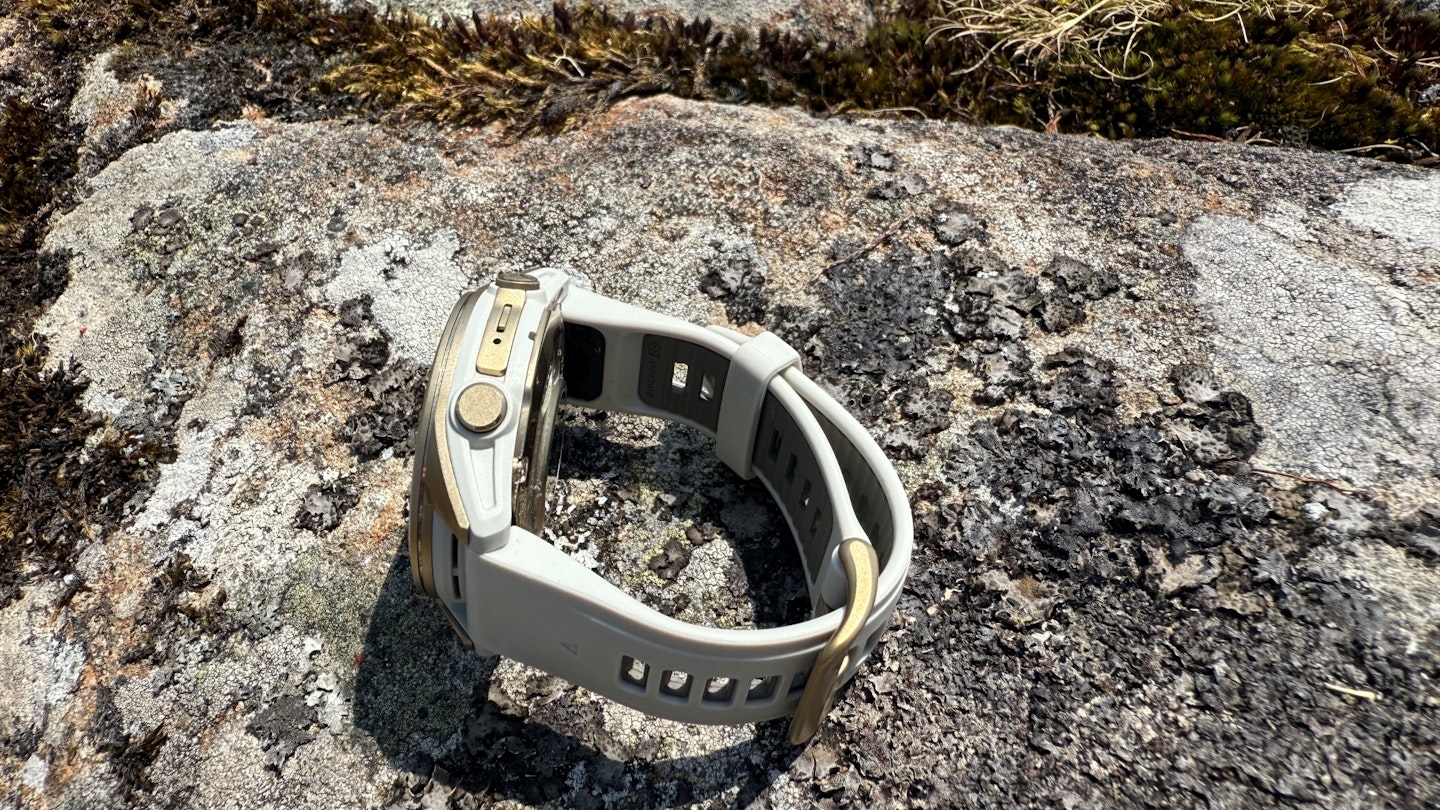
One of the trade-offs with the smaller 43mm model is significantly reduced battery life compared to its larger siblings. In standard smartwatch mode, it lasts up to 10 days, dropping to just four days with the always-on display active. Battery saver mode extends this to 15 days but restricts functionality considerably.
The larger 51mm AMOLED version offers much better endurance: 29 days in smartwatch mode (13 days always-on) and up to 41 days in battery saver mode. This creates a genuine dilemma between size/comfort and battery longevity.
For GPS activities, the 43mm version provides up to 28 hours in standard mode, dropping to 21 hours with multi-band GNSS active, and just 6 hours when streaming music. Max battery GPS mode extends this to 49 hours, while expedition mode (hourly position updates) stretches to 10 days.
For day hikes and most outdoor activities, this battery life is perfectly adequate. However, multi-day expeditions or extended off-grid adventures will require careful power management or external charging solutions, making the larger sizes more suitable for serious expedition use.
Mapping
For us, Garmin's mapping remains the best free smartwatch navigation system available. The Fenix 8 comes with preloaded topographical maps featuring clear contour lines, landscape features, villages, rivers, and roads all clearly labelled. The AMOLED display transforms the mapping experience – details that were barely visible on previous screens now stand out with remarkable clarity.
Navigation is intuitive using either the physical buttons for zooming or the touchscreen for panning (once unlocked to prevent accidental inputs). The combination works seamlessly, offering the precision of buttons when needed and the convenience of touch when appropriate.
Most users will import GPX tracks to follow rather than navigating purely from the base maps. Garmin's ecosystem supports multiple import methods: directly through Komoot integration, via the Garmin Connect or Explore smartphone apps, or through various third-party services. All sync wirelessly and appear ready to use within minutes.

During navigation, you can toggle between map view and customisable data screens showing hiking statistics like pace, distance, elevation gain and time. The GPX track displays your progress while showing the planned route ahead. Turn-by-turn navigation provides audio and haptic (vibrating) prompts, and off-route warnings help prevent navigational errors before they become serious.
The AMOLED screen means that even on the smaller watch face, map details remain easily readable at a quick glance – a significant advantage when you need to check your bearing without breaking stride.
Accuracy
The Fenix 8 features multi-band capability, connecting to all major global navigation satellite systems: GPS, GLONASS, BeiDou, Galileo, and QZSS. This comprehensive satellite access ensures reliable positioning even in challenging environments.
Garmin's SatIQ technology intelligently manages satellite mode selection, automatically switching between multi-band GNSS when precision is crucial and lower-power GPS when accuracy demands are less stringent. This dynamic adjustment optimises battery life without sacrificing reliability.
In testing across various terrain types – from open moorland to dense forest and urban environments – GPS tracks were consistently smooth and accurate. The watch locks onto satellite signals quickly, typically within 10-15 seconds in most conditions.
Heart rate accuracy from the optical sensor is generally reliable for steady-state activities, though it can struggle with rapid intensity changes (like most wrist-based HR sensors do). For most outdoor activities like hiking and trail running, it provides sufficiently accurate data without requiring a chest strap.
Interface
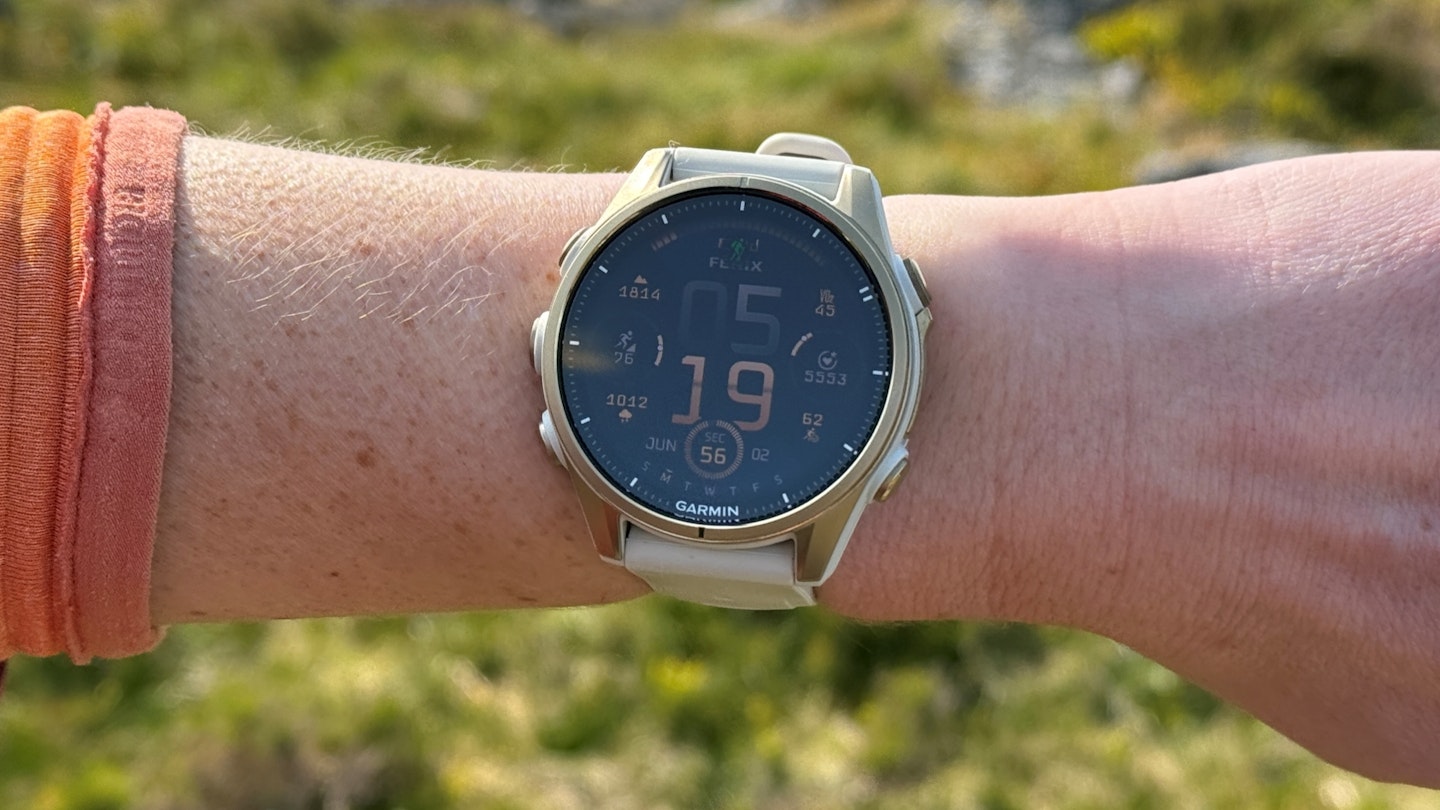
The Fenix 8 uses Garmin's established five-button layout supplemented by touchscreen capability, offering the best of both worlds. If you're familiar with other Garmin devices, the interface will feel intuitive. Newcomers should expect a learning curve as they master the various button combinations and menu structures.
The interface doesn't feel as streamlined as some competitors, partly due to the sheer breadth of data and customisation options available. Various short and long-press combinations access different menus and settings, such as the widgets menu (long-press top left button). While this can feel overwhelming initially, it enables incredibly detailed customisation once mastered.
Fortunately, basic activity recording remains straightforward, so if you're primarily using this as a hiking or outdoor watch, you can get started immediately without mastering every feature.
The touchscreen responsiveness is excellent, making map navigation and menu scrolling more intuitive than button-only interfaces, while the physical buttons ensure full functionality in challenging conditions when touch might be compromised (e.g. when out on the hills in steady drizzle).
App
Garmin's ecosystem is comprehensive but has become somewhat complex, requiring multiple smartphone apps for full functionality. The key apps for outdoor users are Garmin Connect (essential for syncing and activity analysis), Garmin Explore (route planning and management) and Garmin Connect IQ (third-party apps and watch faces).
Garmin Connect handles the core functionality well, with intuitive navigation and comprehensive activity analysis. The app has improved significantly in recent updates, making it easier to find specific features and data.
However, Garmin has attracted criticism for introducing Connect+, a subscription service placing premium features behind a £70 annual paywall. Given the Fenix 8's premium price point, many feel this additional cost is unreasonable.
The subscription offers AI-driven insights, performance dashboards, and enhanced live tracking – features primarily valuable to serious athletes rather than general outdoor enthusiasts.
Other features
The feature list is exhaustive. Health tracking includes sleep analysis with morning reports, heart rate monitoring, blood oxygen levels, stress tracking and Garmin's Body Battery energy monitoring. The ECG app can record heart rhythm and check for atrial fibrillation – a valuable health tool.
Outdoor-specific tools include dual grid coordinates, built-in compass, barometric altimeter, thermometer, weather forecasting, tide times, storm alerts and comprehensive safety tracking with incident detection and live sharing capabilities.
Multi-sport functionality is exceptional, with advanced features for running, cycling, swimming, and dozens of other activities. Training analysis and planning tools rival dedicated coaching platforms.
Smartwatch features include contactless payments via Garmin Pay, music storage with streaming service integration and smartphone connectivity. The new built-in speaker and microphone enable wrist-based calls (with phone nearby) and voice commands – surprisingly useful for starting activities or recording voice notes during outdoor adventures.
Price and competition
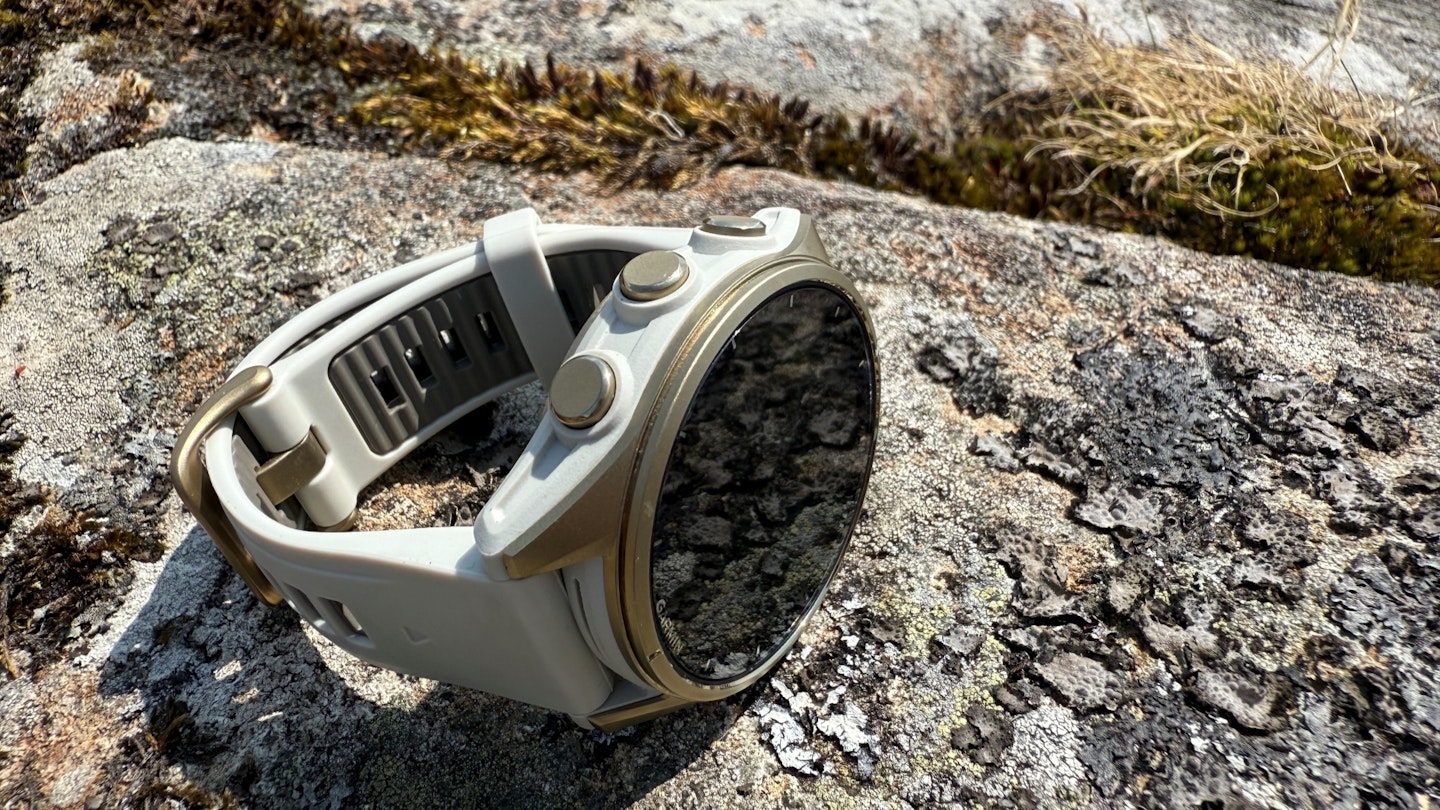
The Fenix 8 AMOLED represents Garmin's premium offering, with pricing to match. The 43mm version starts at £880, climbing towards £1000 for titanium variants with premium straps. Only Garmin's high-end MARQ collection and specialist pro-spec models cost more.
This pricing puts it significantly above competitors like the COROS Apex 2 Pro(£450) or Suunto Race (£345), though the feature gap is substantial. Within Garmin's lineup, it sits above the Forerunner 965 (£499) and Enduro 3 (£770), offering more comprehensive features but at a considerable price premium.
The main competition comes from high-end alternatives like the Suunto Vertical Titanium Solar (£625) or Polar Grit X2 Pro (£649), both offering similar outdoor functionality at lower prices.
Polar’s AMOLED display rivals the Fenix 8’s in terms of quality but doesn’t have the same array of custom watch faces and colours. Neither of those two rivals match Garmin’s comprehensive feature set, either in terms of data tracking or topo mapping.
For those seeking similar functionality at lower cost, the Garmin Forerunner 965 offers most of the same features with a comparable AMOLED display, whilst the Enduro 3 provides superior battery life for serious expeditions.
Verdict
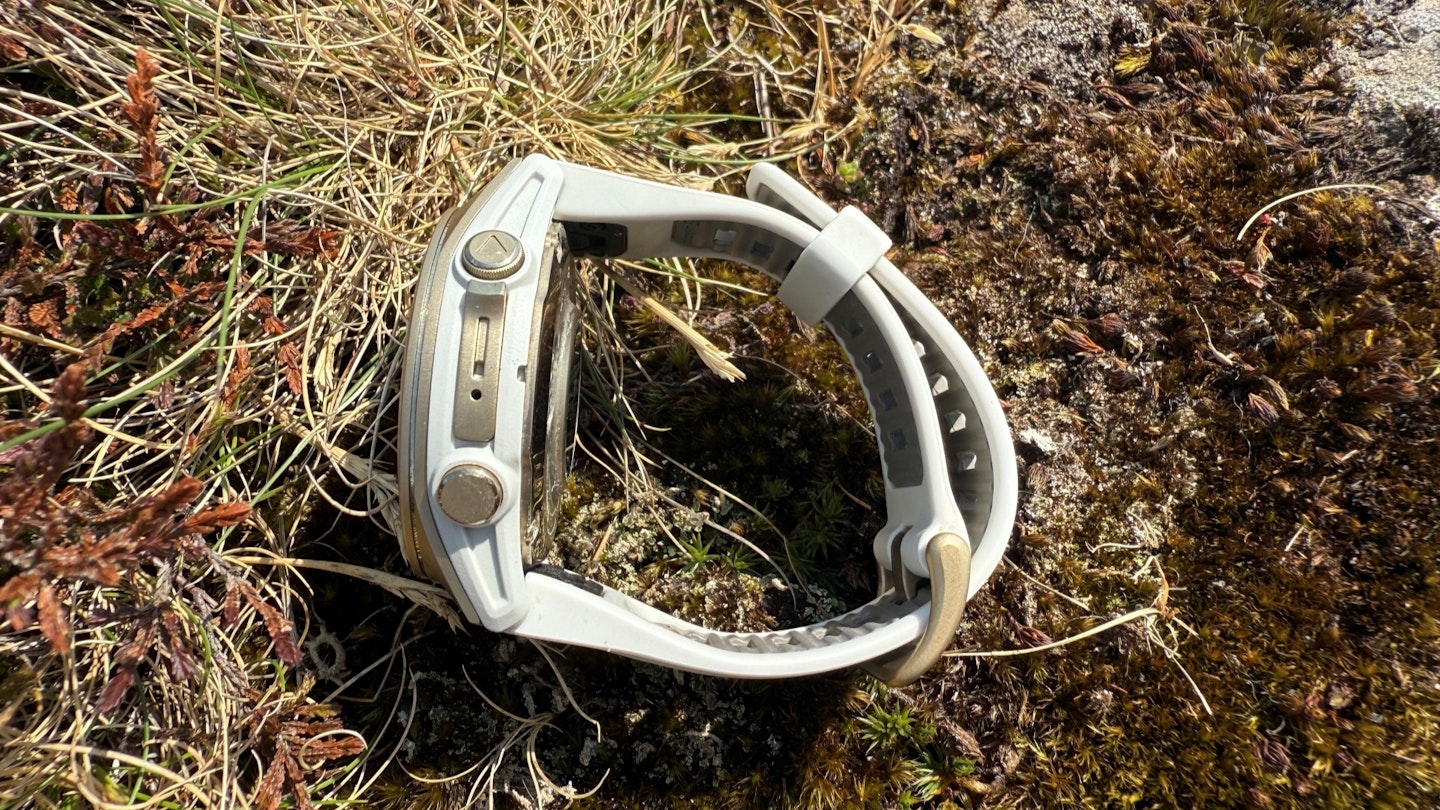
The Garmin Fenix 8 AMOLED represents the pinnacle of adventure watch technology, combining a stunning display with comprehensive outdoor features and premium build quality. For us, the AMOLED screen transforms the user experience, making maps readable and data accessible in ways that previous generation screens simply couldn't match.
For serious outdoor enthusiasts who want the absolute best technology available and can justify the investment, the Fenix 8 AMOLED delivers exceptional capability. The feature set is genuinely comprehensive, covering virtually every outdoor scenario you might encounter, whilst the build quality inspires confidence in challenging conditions.
However, the eye-watering price creates a significant barrier to entry. At £880+, this represents a substantial investment that many will struggle to justify, especially when capable alternatives exist at half the price. The complexity may also overwhelm casual users who simply want reliable GPS and basic outdoor features.
If you're a dedicated adventurer who demands the very best technology and can afford the premium, the Fenix 8 AMOLED justifies its cost through sheer capability and refinement. For most users, however, the Forerunner 965 or Enduro 3 offer better value whilst still providing excellent outdoor functionality.
Shop this product
About the author

Matt Jones is a freelance journalist based in the heart of Snowdonia National Park, he’s a vastly experienced gear tester and self-confessed outdoor kit geek. Matt’s been one of our main gear testers for the last couple of years and is the first person we call with any complicated kit queries that need in-depth and forensic analysis.
